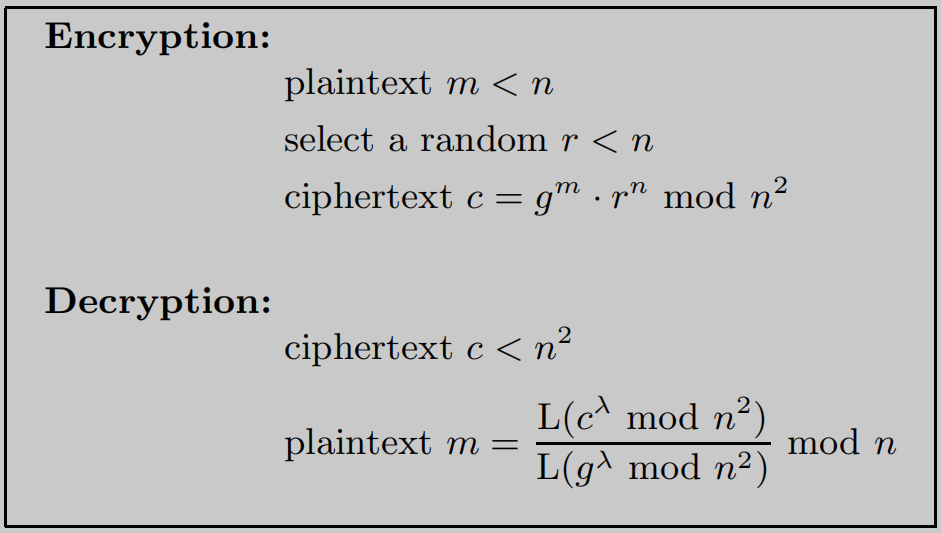not_RSA [题目考点]
[题目文件] Click Here to Download
[题解分析] 从$Z_{n}\times Z_{n}^{}$到$Z_{n^{2}}^{ }$存在双射关系$(x,y)\rightarrow g^{x}y^{n}(mod\ n^{2})$
Paillier cryptosystem系统加解密流程如下:
which $\lambda =lcm(p-1,q-1),L(u)=\frac{u-1}{n}$
Proof:
$g\in Z_{n^{2}}^{*},\quad\therefore \exists(a, b),s.t.\ g=(n+1)^{a}b^{n}(mod\ n^{2})$
$c^{\lambda}=(n+1)^{am\lambda}b^{nm\lambda}r^{n\lambda}=(n+1)^{am\lambda}=1+am\lambda n(mod\ n^{2})$
$L(c^{\lambda}\ mod\ n^{2})=am\lambda$,同理$L(g^{\lambda}\ mod\ n^{2})=a\lambda$,证毕
本题$g=n+1$,且n可以直接Fermat分解得到pq,按上述方法解密即可
[exp] 1 2 3 4 5 6 7 8 9 10 11 from Crypto.Util.number import *p = 80006336965345725157774618059504992841841040207998249416678435780577798937819 q = 80006336965345725157774618059504992841841040207998249416678435780577798937447 n = p * q c = 29088911054711509252215615231015162998042579425917914434962376243477176757448053722602422672251758332052330100944900171067962180230120924963561223495629695702541446456981441239486190458125750543542379899722558637306740763104274377031599875275807723323394379557227060332005571272240560453811389162371812183549 lcm = ((p - 1 ) * (q - 1 )) // GCD(p - 1 , q - 1 ) a = (pow(c, lcm, n * n) - 1 ) // n b = (pow(n + 1 , lcm, n * n) - 1 ) // n m = long_to_bytes((a * inverse(b, n)) % n) print(m)
[More] 单从这道题本身来看,其实不了解这个密码系统也可,因为$g=n+1$,且$r^{n\cdot lcm(p-1)(q-1)}\equiv 1(mod\ n^{2})$,所以$c^{lcm}\rightarrow$ 二项式定理即可得$m\cdot lcm(mod\ n)$
Complex Encode [题目考点]
[题目文件] Click Here to Download
[题解分析] 套娃题- -流程捋顺也就出来了
Step 1:RSA加密,且$GCD(phi_{1},e_{1})=random.randint(3, 12)$,$p_{1}$作为泄露信息进入Step2
Step 2:$p_{1}$作为DSA Signature的私钥,对rsaEncode2(false_flag)签名,并返回
1 2 sig = r.to_bytes(205 , 'big' ) + s.to_bytes(205 , 'big' ) + k.to_bytes(205 , 'big' )+ q.to_bytes(205 , 'big' ) f.write("dsaEncode :" +base64.b64encode(sig).decode()+"\n" )
Step 3:Step 2中的rsaEncode2(false_flag)来自于第二个RSA加密系统的返回值,可以看到gen_prime时用了next_prime,费马分解得到$p_{2},q_{2}$,且发现$GCD(e_{2},phi_{2})=41$,因此先得到了$m_{2}^{41}(mod\ n_{2})$,$F_{p_{2}},F_{q_{2}}$上对$c_{2}$开41次根,并对所有组合crt即可还原$m_{2}$(b'flag{T0o_YoUn9_to0_4imP1e}'),但无意义,该rsa系统返回值为$m_{2}^{41}(mod\ n_{2})$,fine
Step 2中(r, s, k, q, m)均已知,可直接求出私钥x,也即为$p_{1}$
再对第一个RSA系统常规解密得到$m_{1}^{5}$,最后有限域开根crt拿到flag
[exp] 1 2 3 4 5 6 7 8 9 10 11 12 13 14 15 16 17 18 19 20 21 22 23 24 25 26 27 28 29 30 31 32 33 34 35 36 37 38 39 40 m2 = bytes_to_long(b'flag{T0o_YoUn9_to0_4imP1e}' ) ran2 = 41 rsaEnc2 = pow(m2, ran2, n2) from base64 import b64decodesig = b'...' sig = b64decode(sig) r = bytes_to_long(sig[:205 ]) s = bytes_to_long(sig[205 :410 ]) k = bytes_to_long(sig[410 :615 ]) q = bytes_to_long(sig[615 :820 ]) import hashlibHm = int.from_bytes(hashlib.md5(str(rsaEnc2).encode('utf-8' )).hexdigest().encode(), 'big' ) x = ((s * k - Hm) % q) * inverse(r, q) n1 = ... p1 = x % q q1 = n1 // p1 e1 = 0x12a316381 c1 = ... assert (GCD(e1, (p1 - 1 )*(q1 - 1 )) == 5 )d1 = inverse(e1 // 5 , (p1 - 1 ) * (q1 - 1 )) m1_5 = pow(c1, d1, n1) PP.<x> = PolynomialRing(Zmod(p1)) fp = x^5 - (m1_5 % p1) m1_p = fp.roots() PQ.<y> = PolynomialRing(Zmod(q1)) fq = y^5 - (m1_5 % q1) m1_q = fq.roots() tmp = [] for i in m1_p: for j in m1_q: tmp.append((i[0 ], j[0 ])) for (m1p, m1q) in tmp: print(long_to_bytes(crt([int(m1p), int(m1q)], [int(p1), int(q1)])))
